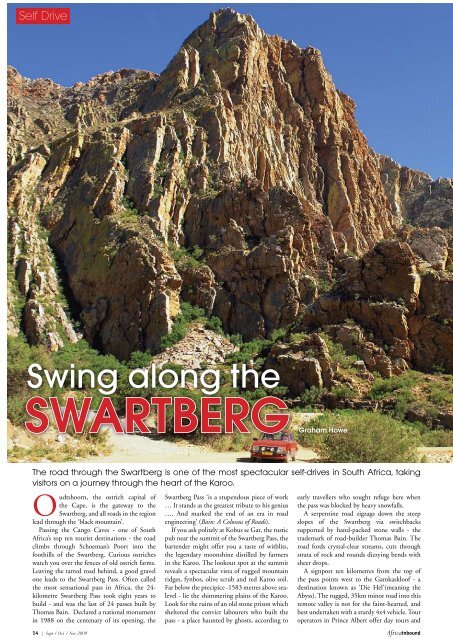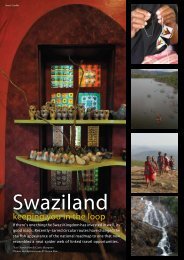info - Sand River Guest House
info - Sand River Guest House
info - Sand River Guest House
You also want an ePaper? Increase the reach of your titles
YUMPU automatically turns print PDFs into web optimized ePapers that Google loves.
Self Drive<br />
Swing along the<br />
SWARTBERG<br />
Graham Howe<br />
The road through the Swartberg is one of the most spectacular self-drives in South Africa, taking<br />
visitors on a journey through the heart of the Karoo.<br />
Oudtshoorn, the ostrich capital of<br />
the Cape, is the gateway to the<br />
Swartberg, and all roads in the region<br />
lead through the ‘black mountain’.<br />
Passing the Cango Caves - one of South<br />
Africa’s top ten tourist destinations - the road<br />
climbs through Schoeman’s Poort into the<br />
foothills of the Swartberg. Curious ostriches<br />
watch you over the fences of old ostrich farms.<br />
Leaving the tarred road behind, a good gravel<br />
one leads to the Swartberg Pass. Often called<br />
the most sensational pass in Africa, the 24-<br />
kilometre Swartberg Pass took eight years to<br />
build - and was the last of 24 passes built by<br />
Thomas Bain. Declared a national monument<br />
in 1988 on the centenary of its opening, the<br />
Swartberg Pass ‘is a stupendous piece of work<br />
… It stands as the greatest tribute to his genius<br />
…. And marked the end of an era in road<br />
engineering’ (Bain: A Colossus of Roads).<br />
If you ask politely at Kobus se Gat, the rustic<br />
pub near the summit of the Swartberg Pass, the<br />
bartender might offer you a taste of witblits,<br />
the legendary moonshine distilled by farmers<br />
in the Karoo. The lookout spot at the summit<br />
reveals a spectacular vista of rugged mountain<br />
ridges, fynbos, olive scrub and red Karoo soil.<br />
Far below the precipice -1583 metres above sealevel<br />
- lie the shimmering plains of the Karoo.<br />
Look for the ruins of an old stone prison which<br />
sheltered the convict labourers who built the<br />
pass - a place haunted by ghosts, according to<br />
early travellers who sought refuge here when<br />
the pass was blocked by heavy snowfalls.<br />
A serpentine road zigzags down the steep<br />
slopes of the Swartberg via switchbacks<br />
supported by hand-packed stone walls - the<br />
trademark of road-builder Thomas Bain. The<br />
road fords crystal-clear streams, cuts through<br />
strata of rock and rounds dizzying bends with<br />
sheer drops.<br />
A signpost ten kilometres from the top of<br />
the pass points west to the Gamkaskloof - a<br />
destination known as ‘Die Hel’(meaning the<br />
Abyss). The rugged, 35km minor road into this<br />
remote valley is not for the faint-hearted, and<br />
best undertaken with a sturdy 4x4 vehicle. Tour<br />
operators in Prince Albert offer day tours and<br />
14 | Sept / Oct / Nov 2009 Africainbound
overnight stays at restored farmhouses, a campsite<br />
and caravans in this remote conservancy.<br />
The dramatic road to Die Hel passes<br />
through Eland’s Pass and fords the ‘Gamka’<br />
(Lion) <strong>River</strong> before descending steeply to the<br />
valley floor 1000 metres below. The secluded<br />
Gamkaskloof was once home to a small<br />
community of trekboers who lived here in<br />
isolation for over a century. Before the road<br />
to the Gamkaskloof was opened in 1962,<br />
access was only on foot or horseback - and the<br />
farmers carried out their harvests of dried fruit,<br />
nuts, tobacco, vegetables and honeybush tea<br />
by pack donkey.<br />
According to legend, when a boer commando<br />
pursued by British soldiers fled into the<br />
Gamkaskloof during the<br />
Anglo-Boer War, they<br />
came across farming<br />
folk dressed in bonnets<br />
and goatskin clothing<br />
speaking old-fashioned<br />
Dutch. Deneys Reitz,<br />
one of the boer soldiers, wrote in his book,<br />
Commando: ‘We spent the night and the next<br />
day with this curious Swiss Family Robinson<br />
and in the evening toiled up the cliffs again’.<br />
The journey to Gamkaskloof ends in this<br />
primordial valley of abandoned farms which<br />
seems more like a Garden of Eden. Getting<br />
there might seem like hell on the hairpin bends<br />
- but the sense of peace and quiet is worth the<br />
trip. The original San and pioneers are long<br />
gone, leaving a sanctuary for horse-riding,<br />
walking trails, birdwatching, caving, and an<br />
overnight donkey trail.<br />
Annetjie Joubert, the last remaining<br />
descendant of the original community, still<br />
welcomes visitors to Fonteinplaas, one of the<br />
old family farms. Her farm stall sells organically<br />
grown fruit, farm preserves, traditional<br />
potbrood (bread), witblits and peach liqueurs<br />
distilled in the old copper potstill.<br />
Visitors who overnight in the two historic<br />
farmhouses of Oupa Piet Mostert and Pietjie<br />
Swanepoel enjoy the traditional farm cuisine<br />
served at the Oude Klowers Farmkitchen.<br />
After sunset, paraffin lamps are lit.<br />
Beyond the Gamksaskloof, the Swartberg<br />
Pass leads to Prince Albert - an untouched<br />
Karoo hamlet with nineteen national<br />
monument homesteads, charming country<br />
guesthouses with cast-iron broekie-lace porches<br />
and oodles of Victorian charm. Prince Albert is<br />
a destination in the heart of the country that<br />
has been resettled by artists, artisans and writers.<br />
The restaurants of the<br />
Before the road to the<br />
Gamkaskloof was opened in<br />
1962, access was only on foot or<br />
horseback<br />
valley showcase the<br />
quality of local farm<br />
produce - from olive<br />
oil, figs and dried fruit<br />
to wines, venison and<br />
Karoo lamb. The art<br />
galleries display the work of local artists inspired<br />
by the Karoo landscape.<br />
Andries Gouws, whose family has lived<br />
here since 1837, is the local distiller licensed<br />
to make witblits on the old potstill at the<br />
fascinating village museum in Prince Albert.<br />
Nearby, you’ll find Soet Karoo, the only wine<br />
estate in the Great Karoo at 56 Church Street.<br />
Herman Perold, the great-nephew of Abraham<br />
Izak Perold, who invented Pinotage, planted<br />
vines in the garden of their guesthouse and<br />
now makes an award-winning red muscadel in<br />
a micro-cellar in the garage. At night, when the<br />
Milky Way in the clear night sky seems close<br />
enough to touch, the hurly-burly of the city<br />
seems like a mirage in this Karoo oasis. The<br />
road through the Swartberg ends here.<br />
Africainbound Sept / Oct / Nov 2009 | 15








